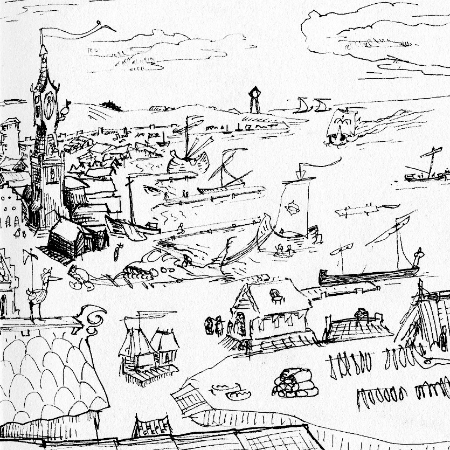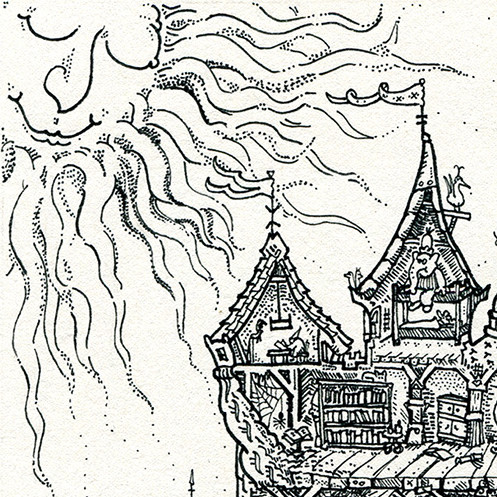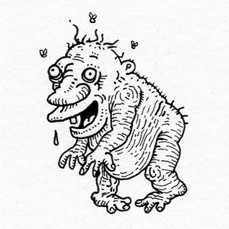
“Grochnaert, Panduryn & Kruytbeert stand guard outside of a Weerhuys.”
Strunkebroekers drigghen altyd –
met besmeuren ende verskeuren –
van d’sgoonste kleeren-
vande Markanten.*
IN THE HEART OF BOS many cities and villages have main entrances in the form of gates or portal-buildings. These towers or donjons play a dual role as administrative centers and fortified lookouts. The gates themselves are in many cases symbolic:
many smaller towns are not completely walled in, and other entrances to the community may well be unguarded. Most traditional rulers’ power rests on agrarian capital, and warlords do not usually like to tangle with the proud and independent city folk. Large cities are often surrounded by extensive fortifications, both within & around the city limits, and may feature multiple Toornepoortes* per district.
THESE ‘TOWERING PORTALS’, or donjons, originated in a distant past, as Weerhuyzen* along the continental trade routes. These modest forts housed small companies of professional men-at-arms and it is around these nuclei that the soldier-profession and inherited Ruyter-tradition* find their origins.
In comtemporary times these roadside fortifications are often managed by Markante Milities*, the military attachés of various trade companies. These company-funded brigades are the proving grounds of merchant sons and aspiring traders; only after several seasons of guard duty and caravan protection are novices allowed make their first attempt at establishing a trade route of their own. This so-called Yzerpraktyk* weeds out the feint-of-heart but is also a breeding ground for the new-fangled & merciless ‘trade princes’.
Most famous among those is Juppe Desnongk*, the utterly pragmatic merchants son who -by sword & pen- built his personal trade empire on his violent monopoly on the fresh-fruit business in and around Brauec↓.
OM THE FOREGROUND of the illustration we see Grochnaert & Panduryn (and Kruytbeert in the distance)*. They are a trio of freelance guards who scout ahead of the seasonal caravans. They are momentarily posted at a Weerhuys west of Arys*. Past the hills lies the coast, where mollusc-season has begun.
Soon all manner of colorful seafood will be rushed towards the inland cities.
Notes
“Strunkebroekers drigghen altyd met besmeuren ende verskeuren van d’sgoonste kleeren vande Markanten.”
translates to: “Bushwhackers always threaten to smear and tear a Merchants finest clothes.”
Strunkebroekers — bushwhackers, they cover themselves in foliage and hide in the roadside hedges. Often their main objective is no just to relieve the passing traders of their coin, but also to ridicule their pompousness. They achieve this by tearing up their victims pants, smearing dirt over their exquisite tunics or doublets, and tying knots in their fancy hats.
Toornepoorte — Portal-tower, donjon.
Weerhuys —
1) a small, round fortification built by local strongmen to safeguard the main traderoutes. Maybe unsurprisingly their occupants are often the very ones unfairly ‘taxing’ the passing caravans…
2) outdated fort design, a stone roundhouse with palisades.
Markanten — Merchants, specifically those belonging to large trade companies.
Ruyters — Riders; any type of rider with military function. Also a noble title that is not inheritable, also used as catch-all term for armored combatants, whether mounted or not.
Markante Militie — Merchant Militia, a division within a trade company where novices learn the ‘tricks of the trade’ through escort- and guard duty.
Yzerpraktyk — Iron Practice (aka Iron Gauntlet)
Juppe Desnongk — more on this merchant prince can de found in the article on Bos Characters.
Brauec — an inland region with orchards aplenty, sheltered by soft sloping hills.
Grochnaert — From French: ‘grognard’ (grumbler), name given to soldiers in Napoleons ‘Old Guard’.
Panduryn — From Dutch: ‘pandoer’, loanword from Hungarian or Serbian: ‘pandur’, infantry under Austrian Habsburg rule.
Kruytbeert — ‘gunpowder beard’
From Dutch: ‘kruit’ (gunpowder) & ‘baard’ (beard)
Arys — The ‘City of Twelve Doves’






